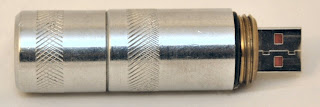Now that we've done our basic design and research for our rugged USB drive it's time to start making something! I'm a very amateur machinist and the basic design for the drive case is simple enough for me to attempt to make, at least for the testing prototypes.
I choose Brass for the first prototype's material for a number of reasons:
Brass Pros
- Easy to machine
- Cheap
- Shiny!
|
Brass Cons
|
This is fine for a simple prototype but the Brass cons are more than enough to consider other materials for the final product (materials are to be discussed in a future blog entry).
The design of the VIUD case is relatively simple and is composed of three parts:
- Cap - Removable part that covers the USB connector and attached with thread.
- Base - Main body of the USB
- Plug - Threaded plug which the USB fits into and is permanently mounted into the base.
 |
| Basic Components of our VIUD Design |
Machining these parts is relatively simple, even for an amateur, although there are a few "gotchas" to note:
- Using a tap to manually create the threads is difficult at best. You have to tap before machining the case OD or else the body walls buckle outwards.
- It is difficult/impossible to create a perfectly straight thread with manually tapping (even with a jig) which causes the cap to not sit perfectly on the body. This can be corrected by filing the edge of the cap but is tedious.
- The hole in the plug for the USB connector is machined with round corners and needs to be filed out square.
- The groove in the plug for the main o-ring seal was done after assembly and the epoxy had hardened to ensure a perfect fit.
- The mount for the cap at the end of the base was added afterwards by press fitting an additional piece into the base.
For the USB flash drive itself I merely purchased a cheap 2GB consumer level drive and removed the plastic case. Assembly merely required to insert the USB into the rear side of the plug, fill the base with epoxy (enough to squeeze out when assembled) and screw the plug into the base. After letting the epoxy dry and machining a groove for the o-ring seal in the plug the first prototype VIUD is finished! Unfortunately I don't have any pictures of the prototype before its destruction in stress testing.
Testing
 |
| End-to-End Stress Modelling |
Our first VIUD prototype may not look too pretty but it is fine for basic testing of our design. First is a simple handling test: How does the drive feel in terms of weight and size. The size feels fine although it is significantly larger than most USB flash drives these days. It is a little on the heavy side, however, at around 150 g. Not terrible but a little too noticeable when held in your pocket. The overall physical operation of the drive is also fine and doesn't reveal any unforeseen difficulties.
Next, with our simple and cheap pressure testing rig we can easily see what pressure our prototype can handle. Fortunately, even with a slightly crooked cap it successfully passed a 1 hour test at 3000 psi with no leaks!
Temperature testing was next and I was evidently a little too eager at this stage by using a propane blow torch. Even with just a 2 minute external exposure of 1100 °C the plastic in the USB connector melted completely and a quick repair attempt failed to get the USB drive to respond when plugged in to a computer.
Since the drive was already toast the next and final test was the destructive stress test. I purchased a basic 10 ton hydraulic press from my favourite store Princess Auto. I had done some basic stress modelling using Solidworks and Autocad Inventor which showed the failure of the Brass prototype should occur at around 4000-5000 lbs on the threads of the cap with a vertical load. The modelling proved very accurate as that is exactly when and where the prototype failed! We usually assume modelling is reasonably accurate but it is always nice to see it verified once and a while.
 |
| Brass VIUD Prototype #1 -- After Destructive Testing |
Lessons Learned
Despite the first prototype being destroyed during testing it yielded a number of important insights:
- Validated the overall design.
- Handling pressures up to 3000 psi should be no issue.
- Brass is too heavy and too soft a material for a true VIUD.
- Manually trying to tap the threads myself doesn't work very well.
- The mechanical stress modelling agrees very well with the actual stress testing.
- Temperature testing will have to be done a little more carefully (no propane torch)!
More prototypes, testing and research await for us on our quest for the ultimate VIUD....







